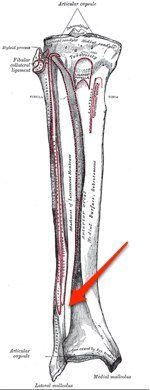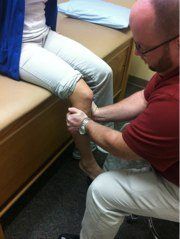As football season is upon us, we often hear the term “high ankle sprain” used by announcers and in the media. This guest article from Trevor Winnegge will help to explain this orthopedic diagnosis, etiology, diagnostics and treatment.
What is a high ankle sprain?

Mechanism of High Ankle Sprain Injuries
While trauma to the ankle in any position has potential to injure the syndesmosis, ankle external rotation and forced dorsiflexion are the two most common injury mechanisms. Normally, the talus is positioned between the medial and lateral malleoli and is unable to rotate substantially. However, with a great enough force to the forefoot, the talus is forced to rotate laterally, thereby pushing the fibula externally away from the tibia, widening the mortise. This type of injury is often seen in football and skiing.
Typically, ankle dorsiflexion causes the interosseous ligament to become taut. However, since the anterior aspect of the dome of the talus is wider than the posterior aspect, the wider portion of the talus pushes or wedges the malleoli apart during extreme dorsiflexion. This mechanism of injury is more common in running and jumping sports. High ankle sprains can occur isolated, can involve fracture of the fibula or medial malleolus, or tears of the lateral talofibular and medial deltoid ligaments.(2) High ankle sprains occur in up to 15% of all ankle sprain injuries.
Clinical Examination

A “Squeeze test” can be performed as a clinical test of syndesmotic instability. This is a simple, moderately reliable test where the examiner squeezes the proximal calf of the patient. A positive test occurs when this maneuver causes distal syndesmotic pain.(3)
Diagnostic Imaging
Plain film Xrays are useful in ruling out fractures, but may be negative in an isolated high ankle sprain. Stress Xrays are most useful, where the foot is stressed into external rotation or dorsiflexion. This will show a widening of the ankle mortise. MRI/CT Scan can confirm the diagnosis and document severity of the injury.
Treatment of High Ankle Sprains
Treatment of high ankle sprains depends on the severity of the injury. Conservative care can be used to treat minimal to moderate injuries. Treatment may consist of a walking boot or nonweightbearing cast for anywhere from 1-4 weeks. Most athletes will return to sports in 6 weeks but many remain symptomatic for up to 6 months. A general rule of thumb, though not set in stone, is that the higher up the leg symptoms go, the larger the severity and longer the injury will take to heal.

Physical therapy for both conservative and non-operative care consists of range of motion, strength, stability and functional training to allow progression back to sports or activity. It is important to remember that this is can be a severe injury and healing times are much longer than a typical lateral ankle sprain, despite the lack of edema.(4,5)
References
- Norkus S, Floyd R. The Anatomy and Mechanisms of Syndesmotic Ankle Sprains. J Athl Train. 2001 Jan-Mar; 36(1): 68– 73.
- Norkus S, Floyd R. The Anatomy and Mechanisms of Syndesmotic Ankle Sprains. J Athl Train. 2001 Jan-Mar; 36(1): 68– 73.
- Alonso A et al. Clinical tests for Ankle Syndesmosis Injury: Reliability and prediction of return to function. JOSPT. 1998, 27 (4): 276-284.
- Press CM et al. Management of ankle syndesmosis injuries in the athlete. Curr Sports Med Rep. 2009 Sep-Oct;8(5):228-33.
- Schepers, T. To retain or remove the syndesmotic screw: a review of the literature. Arch Orthop Trauma Surg. 2011 July; 131(7): 879–883.
About the Author





